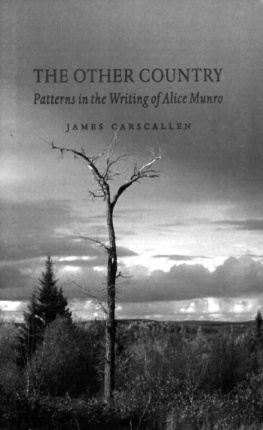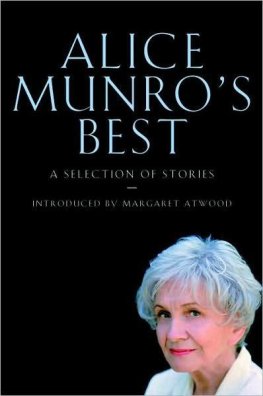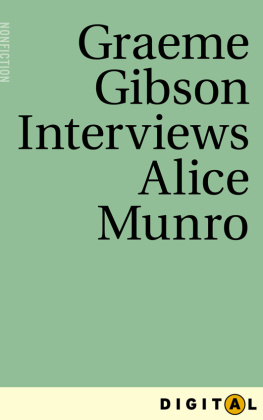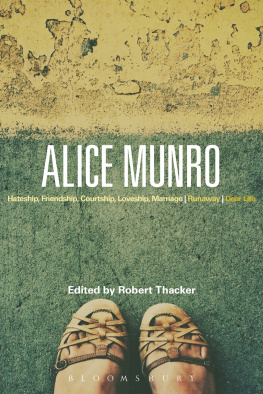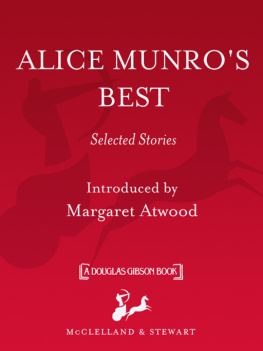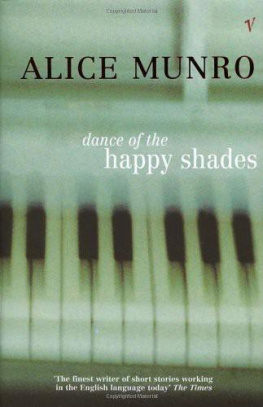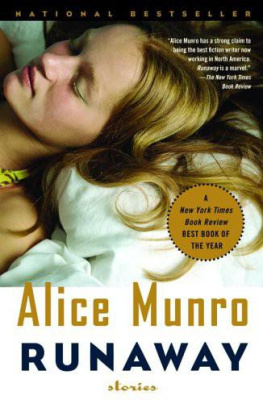J A M E S C A R S C A L L E N



....... vii
...... X
Part r
... I
.... 12
CHAPTER...... 44
...... 66
...... 75
...... 83
...... 119
...... 125
..... 140
...... 145
Part i r
.... 163
CHAPTER.... 179
..... 196
...... 217
CHAPTER 2:.... 260
.... 314
...... 318
..... 329
CHAPTER 3:.... 350
.... 354
...... 369
.... 388
..... 407
.... 410
CHAPTER 4:... 461
... 474
.... 478
..... 494
.... 505
..... 511
.... 531
.... 548
..... 551
... 555

The following book is offered, not just to Munro specialists, but to anyone who has found her work enjoyable and moving. For this reason among others I have tried to write in plain English, even if in places I have had to stipulate a special meaning for a word or phrase. Similarly, I have not counted on knowledge that a general reader would not possess or have readily available. Munro's uncollected stories are no doubt hard to get at, not to mention her unpublished ones. Where I have felt the need to refer to these, I have tried to supply necessary information; in any case they play no great part in my argument. Draft materials play even less: the different versions of Munro's work merit a thorough study, but trying to incorporate one into this book would have produced chaos, as would unwillingness to posit that a Munro story is whatever it finally became. I have also stuck pretty closely to the stories themselves as my evidence, believing that a study of the present kind cannot depend on an author's conscious intentions. Thus I have used Munro's comments on her work only sparingly and never to settle a matter; I have consulted her personally only on a couple of factual points. Except simply as the author of her writing, she is not responsible for any of my interpretations, and has given none of them her certification. Anyone with Munro's books on hand is hence in much the same position as I have chosen for myself.
Part i of my study sets out my interpretative model as it applies to individual stories. To some extent this has meant going over familiar ground, much of it covered more thoroughly by others; to some extent my model differs from ones commonly used for Munro. What I would like to emphasize here is that it is Munro I am using it for. Like any model it can be applied to more than one thing (though its particular form here is meant for the writing of a particular author); but where I have noted analogues in other writing, perhaps alluded to by Munro herself, it is always the form of her own work that I am trying to clarify. And just as I am not offering a general interpretative model, so I am not offering a general treatise on literary theory - or Canadian literature, or the short story. For the most part the only criticism I mention explicitly is that dealing with Munro herself. (I should add that some of this, such as Magdalene Redekop's study, appeared too late for me to use.) If I had gone farther - if I had, for instance, canvassed general theories of story form from Aristotle and Donatus to Propp, Greimas, Frye, Todorov, and beyond - an already long book would have turned out far longer and more elaborate, while losing such focus as it can claim. I do make clear, I think, what my interpretative principles are and why they seem to me to apply to their stated object.
In the second and longer part of my study, I both shift my emphasis from theory to practice and extend my scope from individual stories to the groupings they make. Munro's single stories seem to me to fit implicitly into a larger one of the same kind as themselves; they can be grouped by being associated with its individual phases, which they follow as well in their ordering - most plainly in the two novels but also, to a remarkable extent, in the five collections of independent stories. Here as elsewhere I try to make plain what I do not mean: the phases are not pigeon-holes, and no story is simply "in" one of them, since they not only mirror each other, but in principle can all be found in every story. Thus pieces from anywhere in a book may help to illustrate a phase with which those in a particular location are linked in a more special way.
If the relation of Munro's stories to groups, and these groups to each other, is a tricky matter to describe, so is her way of presenting such grouping and more generally her way of presenting meaning. Her work offers us the great human myths, but as half-concealed - both from the characters themselves and from the reader - behind a surface ordinariness that seems anything but mythical. To argue for something beneath this surface, and something with a structure, takes a fair amount of exemplifying and explaining - especially as structure in Munro can be fairly complex. To argue that a given story is linked to some one part of such a structure takes more explaining again: my exposition, consequently, has had to be a long one (and even as things are I leave a good deal to the reader). The concealing I have mentioned also requires some compromise in sequence. The structure inherent in Munro's work is orderly like any structure, but in actual reading we come to it through what in a way is its opposite: associative connections like that of similar characters with names sounding like "Mary." When my argument moves like an exploring reader along paths of association, structure may not seem its concern at all. But not only will groupings like the "Mary" names reveal little structures of their own; they will turn out to be parts of the larger structure that, I hope, is building itself throughout.
When speaking of the structure of Munro's work, I of course mean that of her work up to the recent past: not owning a crystal ball, I have no way of knowing what she will do in the future. And much as I would have liked to use a story like "Carried Away," I have chosen to stop with the collection Friend of My Youth, after which there was a notable gap in her publishing. Even Friend of My Youth, for that matter, is not treated as fully as the earlier books: the stories it includes came out when my work was substantially complete, and while they do appear both in my main text and more especially in my notes, I generally use others to develop my argument. But then I have made no effort to give Munro's stories equal coverage: the earlier ones, for instance, get what may seem a disproportionate emphasis, since they often show clearly what appears in subtler and more complex forms later.
Since this study is not a survey - it does not follow Munro's dates of publication or, for the most part, deal with one story or collection after another - the editors and I have tried to help the reader both with a liberal amount of cross-referencing and with an index of stories and characters. At the same time, the ordering of the stories in their collections is important for my argument, and tables of contents for Munro's books will accordingly be found on pp. 548-50 - an aid that any reader without a freak memory is likely to welcome. American and British readers will want to know that what was published in their countries as The Beggar Maid appeared in Canada as Who Do You Think You Are' It may also be worth pointing out that, in this book as in most others, a title like Dance of the Happy Shades refers to an entire collection where one like "Dance of the Happy Shades" refers to an individual story. "Tener" in the notes, followed by catalogue numbers beginning with "37," refers to jean M. Moore and Jean F. Tener, The Alice Munro Papers, First Accession (see bibliography); when followed by numbers beginning with "38," it refers to Jean M. Moore, The Alice Munro Papers, Second Accession.

